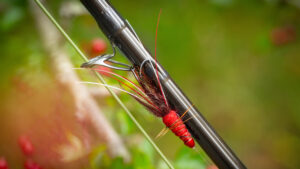WITH THE ABILITY TO FISH DEEPER, SLOWER, WITH MORE CONTROL AND INCREASED CASTING PERFORMANCE, THE GAMECHANGER CERTAINTLY LIVES UP TO ITS NAME!
The RIO Skagit Max GameChanger has become one of the most popular and talked about DH lines in UK fishing today. Most ghillies will have used one and, in most cases, have one ready for early spring and high-water fishing due to the increased depth control and casting performance the line gives. The GameChanger series are multi-density Skagit heads designed for casting big flies and sinking tips. All have a floating rear section and are available in three different multi density options F/H/I, F/H/I/S3 and F/I/S3/S5, ranging in length from 23ft to 25ft depending on the head weight, More info here.


High-water
Full floating Skagits, while perfect for some situations, can suffer from the sink tip rising in a strong flow. With the GameChanger, only a small rear section of the head floats, meaning there’s more weighted line to cut through the heavy water, achieving more depth, extra control and a slower swing of the fly. The GameChanger’s smooth density transition also ensures a straighter line down to the fly, reducing the sag typical in single-density lines, which have their thickest and heaviest parts in the mid or rear section. The fastest sinking portion of a Gamechanger is at the tip, giving direct contact and better bite detection. This is further enhanced by the line’s ultra-low stretch connect core.


Tips
To balance your GameChanger, the correct sink tip must be selected. There are three considerations when choosing the tip for your set-up.
Weight: A tip that’s too light for a given head weight will not provide a sufficient anchor point for the D-loop and will potentially turn over too fast when cast. On the other hand, too heavy a tip, and the head will struggle to turn everything over.
Density: The added tip should at least match the sink rate at the tip of your GameChanger. For example, an Intermediate Tip attached to a F/I/S3/S5 would create an imbalance in the system. The choice, in this case, would be an S6 or faster sinking T Tip.
Length of tip: The sink-tips length should be around the same length as your rod. A tip that’s too short will result in an anchor point that’s likely to slip, especially when trying for distance, with more tension and force applied to the D-loop. Too long a tip, and we’re back to losing our turnover, with too much line stuck at the anchor point. RIO Skagit MOW Tips come in 10ft to 12.5ft sizes which are more suitable for Switch and DH rods up to 13ft. For rods of 13ft to 15ft which are most commonly used in the UK for spring and high-water fishing, there are two options of sink tips which I would recommend using with RIO GameChanger heads:
RIO 15ft Replacement Tips: These are line weight specific, for example, matching a 725grain, F/H/I/3ips GameChanger with a 15ft #10 rod – a 15ft, #10, sink 6-replacement tip would be a great choice.
InTouch level T Tips: Available in 30ft coils of T8, T11, T14, T17 and T20, with welded loops on both ends. Each tip is designed to be cut and tuned to the angler’s individual fishing and casting requirements, RIO Welding Tubing is also available to create the perfect loop.


Taper
The floating rear section of the GameChanger allows the line to be mended and controlled during the swing, something that is almost impossible to achieve with full sinking heads without the skill of ariel mending. In essence, the GameChanger has the depth potential of a full sinking head, with the speed, angle and depth control of a multi-tip, floating head system. Most Skagit heads in line ratings #8 – #11 are around 23 –25ft in length. This short, heavy head doesn’t allow much room for taper. While this makes them perfect for casting in tight situations, with enough power to deliver a set of car keys into a headwind, the short head and lack of taper make many Skagits appear wobbly in flight and requiring taming during casting, that for many can feel alien.
A smooth density transition also means a smooth taper down to the tip, effectively giving the GameChanger more of a Spey taper. From a Spey-casting and fishing standpoint, this is a huge positive and, in the opinion of many, the line’s biggest advantage. A line that keeps its loop shape and remains stable is less susceptible to drag and, consequently, will fly for longer. It also looks much better in flight, compared to the ‘spaghetti Skagits’ of old.
This Spey taper helps in other ways too. It’s my own experience, after watching many people cast GameChangers, that provided water-born casts are selected, and a few key points are obeyed, the transition to a GameChanger is very straightforward, quickly achieving great results without the need to adjust casting style much at all. With the ability to fish deeper, slower, with more control and increased casting performance without compromising turnover potential, the GameChanger certainly lives up to its name.
JIM FEARN






